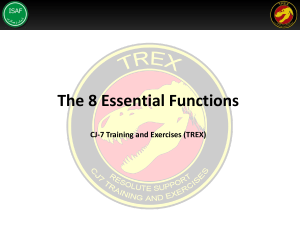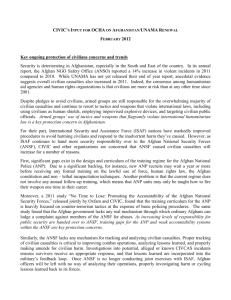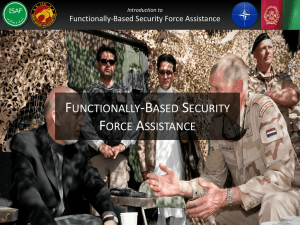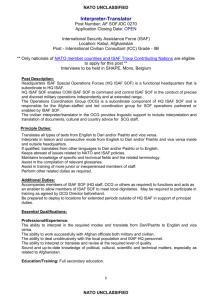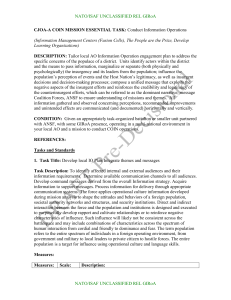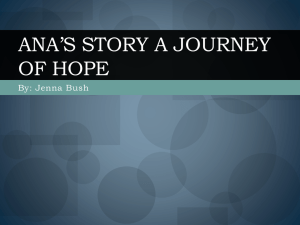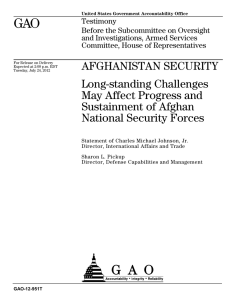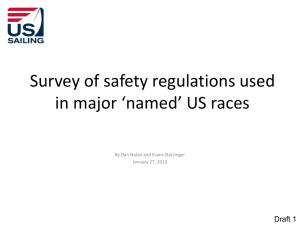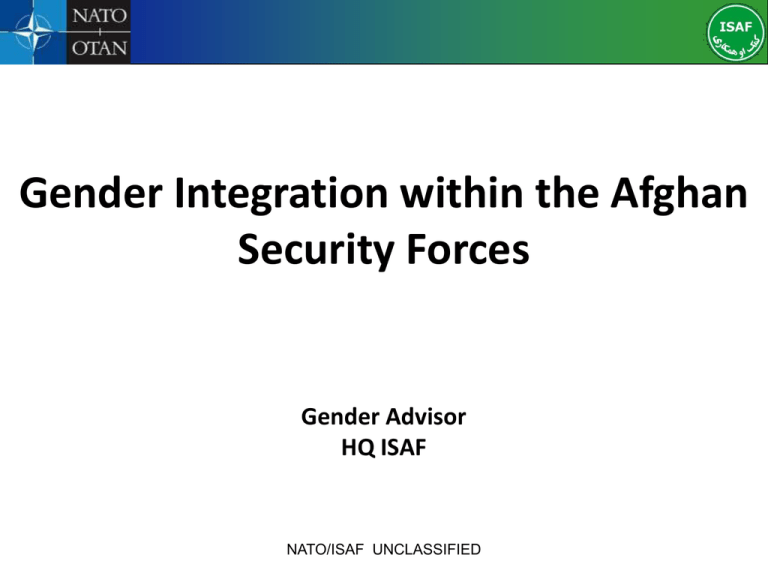
Gender Integration within the Afghan
Security Forces
Gender Advisor
HQ ISAF
NATO/ISAF UNCLASSIFIED
Aim of presentation
1.Increase awareness and understanding of
status on gender integration in ASI/ANSF for
all advisors.
2.Discuss gender in a broader Afghan cultural
context.
NATO/ISAF UNCLASSIFIED
Legal Framework
The Constitution of IR of Afghanistan:
• Article 22:
“Any kind of discrimination and distinction between citizens of
Afghanistan shall be forbidden. The citizens of Afghanistan, men and women,
have equal rights and duties before the law”.
• Article 43 states that education is the right of all citizens of Afghanistan
• Article 44 determines that the state “shall devise and implement effective
programs to create and foster balanced education for women,…”
• Article 48: “Work is the right of every Afghan”.
• Article 52 states that state will provide free preventative healthcare and
medical facilities to all citizens .
• Article 55: “Defending the country shall be the duty of all citizens of
Afghanistan”.
NATO/ISAF UNCLASSIFIED
GIRoA
•
•
•
•
•
Afghan National Priority Programme 2010-2013
Afghan National Development Strategy (ANDS) 2008-2013
The National Action Plan for Women of Afghanistan (NAPWA) 2008-2018
Law on Elimination of Violence against Women (EVAW) 2009
National Action Plan on Women, Peace and Security (pending approval)
NATO/ISAF UNCLASSIFIED
Afghan’s Goals
Plans And Policies In Place
MoI
MoD
Plans and strategies in place – only lacking
implementation
Plans and strategies in place – only lacking
implementation.
•
•
•
•
•
•
•
•
•
2009: Directive on female recruitment (2011
first time mentioned the 5.000 female goal
end of 14)
2013: Directive on Harassment 018
2013: Gender Policy
2013: Policy on prevention of sexual violence
against women and children
2013: Strategy for the Management of the
Affairs of ANP Female Personnel
2014: National Police Plan
2014: National Action Plan
2014: Strategic Implementation Plan on
Solidarity of Female Personnel Affairs within
ANP (August 2014)
Goal: 5,000 women in MoI/ANP by the end
of the year; 10,000 in next 5 years; 10% long
term
•
•
•
•
•
•
•
•
2010: Order to Train Utilize Assign females
in the ANSF
2013: Human Rights and Gender Integration
Directorate Working Plan from 2013-2016
2013: National Military Strategy
2013: Female accession management policy
2014: Order dated 19 – 1 – 1393 of Defense
Minister for 1393 Training Year
2014: Order Regarding the female
recruiting, training, assignment,
reassignment and working facilities within
the Afghan National Army
2014: Order number 1409 dated 3 – 2 –
1393; Annual female recruitment plan
Goal: 10% of the ANA/AAF in 10 years
NATO/ISAF UNCLASSIFIED
Gender Integration within the ANSF
End state:
Through integrating UNSCR 1325 and a gender perspective, with the objective to have
the ASI and ANSF respect gender equality, women serve actively and meaningfully in
the ANSF and contribute to the security and stability of the country.
What has to be done:
1. Remove the barriers for women to serve in the ANSF.
2. Increase awareness and understanding of gender integration in ASI/ANSF and
implement UNSCR 1325 and related resolutions at all levels.
3. Reduce the risk of sexual and gender-based violence within ANSF in order to
enhance professionalization of the force.
4. ASI/ANSF leadership recognizes the importance Afghan women can continue to
make to the security and stability of the country.
5. ISAF/RS strengthen dialogue with GIRoA, Parliament members and civil society on
topics related to UNSCR 1325.
6. Increase cooperation and coordination with International Organizations, Embassies,
GOs and NGOs.
NATO/ISAF UNCLASSIFIED
1.1 Gender Integration MoD (ANA/AAF)
Milestones:
01 Mar 14
A BC
D
31 Jul
E F
31 Oct
G
H
31 Dec 14
01 Jan 16
Decisive Points and Challenges:
Current Assessment:
In Feb 2010 the MinDef issued order about training, utilization and
assignment of female recruits, stating that 10% of the total ANA strength
should be women (should be achieved in 10 year period). MinDef reinforced
this in 2013 with a 3 year Working Plan from 2013-2016 and in Sep 2013 the
ANA Female Accession Management Policy was approved. In Apr 2014
MinDef announced the Annual Accession Plan for Capacity of ANA Female
Training Establishments for recruitment and training, which states that 485
women can be trained each year in the current ANA training facilities.
Recruiting females remains a challenge, we see little effort from ANA to fill
the female classes approved in the MoD annual female recruitment plan.
Only 69 out of 245 female training posts have been filled for courses so far
this year. The actual number of women trained will most likely be only 30%
of this.
A
Conduct an awareness and advertising campaign to change attitude and
opinion towards females in ANA and enhance recruitment (EF# 1,4,8, GA).
Encourage educated women to join the officer training of the ANA (EF# 4).
Provide safe and secure training and working conditions (facilities,
transportation) and as well as uniforms and boots (EF# 1, 5).
TAA on sexual harassment and violence in-workplace and establish
effective complaint mechanism for sexual and/or abuse complaints (EF# 3,
4, GA).
Help Needed:
1. ISAF leadership and advisors convincing MoD/ANA to do some real effort on
recruiting women prior to planned courses; ISAF leadership united in their
KLEs with ASI/ANSF on conditionality of future funding (connected to the
development and sustainability of the ANSF).
2. Other international actors (IOs, Embassies, NGOs, GOs) are sending the same
message and influence Afghan authorities.
•
KMTC Officer Candidate School (OCS)
Result; 30 out of 35 seats filled
B
Female class planned at;
• KMTC NCO Course.
Result; Course cancelled; NONE of 50 seats filled
C
Female classes started at;
• National Military Academy of Afghanistan
• Afghan National Army Officer Academy
Result; 39 out of 75 seats filled
D
Female class planned at;
Way Ahead:
Female class started at;
•
KMTC (NCO) & KMTC (OCS)
Result; Courses postponed NONE of 85 seats filled
E
F
G
H
Female class planned at;
•
KMTC (NCO) & KMTC (OCS)
Female class planned at ;
• Afghan National Army Officer Academy.
Female class planned at;
• ANA OA, KMTC (NCO), KMTC (OCS)
End 2016 with 485 women trained pr. year.
• 2000 women in ANA
7
1.2 Gender Integration MoI (ANP)
Milestones:
A
01 Mar 14
31 Jul
B
31 Oct
CD
E
31 Dec 14
Decisive Points and Challenges:
Current Assessment:
MOI has increased the number of female positions on the 1393 Tashkil
to a total of almost 5,000 but recruitment remains slow and
insufficient to support the population’s needs. ( In 2014 MoI published
the Strategy for the Management of the Affairs of ANP Female
Personnel specified recruitment of 5,000 females in the short term,
10,000 in the medium term and having 10% female police in the long
term).
Providing safe working environment for the projected 5.000 female
ANP by the end of SY1393 will require significant united effort at all
levels.
Abuse of police women remains an accepted fact and official
complaint mechanisms are not effective.
Illiteracy is a problem within ANP, both among males and females.
Way Ahead:
Conduct an awareness and advertising campaign to change attitude and
opinion towards female police and enhance recruitment (EF# 1, 4, 8, GA)
Encourage educated women to join the officer training of the ANP and
increase attendance of literacy programs within the ANP (EF# 4)
Provide safe and secure training and working conditions (facilities,
transportation) and as well as uniforms and boots (EF# 1, 5)
TAA on sexual harassment and violence in-workplace and establish
effective complaint mechanism for sexual and/or abuse complaints (EF#
3, 4, GA)
Help Needed:
1. ISAF leadership and advisors united in their KLEs and engagements
with ASI/ANSF on conditionality of future funding (connected to the
development and sustainability of the ANSF)
2. Other international actors (IOs, Embassies, NGOs, GOs) are sending
the same message and influence Afghan authorities.
F
01 Jan 16
A
B
C
D
17.500 women volunteered as female searchers for the
elections
Identify Tashkil positions for females leading to gender
integration across ministerial lanes
• Evaluate Tashkil structure of MOI and identify
approved positions for females based on appropriate
situations, requirements and conditions.
• Recruit qualified females into identified positions.
Implementation Plan of Female Personnel
• MININT expected to signed a detailed plan of
female recruitment, training and promotion within
ANP.
Implemented Police Inherent Law for increasing
promotions and standardized HR processes
• ANP must sustain promotion commission
capabilities (merit based promotion).
E
Target: 5.000 Police women
F
Target: 10.000 Police women
8
Women in ANSF
ANSF Members
Officers
Bridmals (NCOs)
Soldiers/patrolmen
AAF
20
19
ANA
251
286
ANP
280
886
Total
551
1191
9
122
950
1081
78
66
144
737
2182
2967
Cadets (Officer training)
48
NATO/ISAF UNCLASSIFIED
December 2013 – June 2014
Officers
Bridmals (NCOs)
1000
1000
800
800
600
600
400
400
200
200
0
0
December January February
AAF
March
ANA
April
May
June
December January February
ANP
AAF
Soldiers/Patrolmen
1000
800
800
600
600
400
400
200
200
0
0
AAF
March
ANA
April
ANA
April
May
June
May
June
ANP
Cadets (Officer training)
1000
December January February
March
May
June
December January February
ANP
AAF
NATO/ISAF UNCLASSIFIED
March
ANA
April
ANP
Operations; Different
Security threats against
men, women,
boys and girls
security
needs
Men
Women
Boys
Girls
Robbery
Domestic violence
Gang violence
Infanticide
Assault
Sexual assault
Child abuse and
rape
Child abuse and
rape
Homicide
Dowry death
Bullying
Child marriage
Gang Violence
Sexual harassment
Kidnapping
Kidnapping
Forced to
participate in
sexual violence
Domestic homicide
Exposure and
abandonment
Female genital
mutilation
Rape and sexual
torture
Stalking
Human trafficking
Human trafficking
Human trafficking
Prostitution
Prostitution
Prostitution
Child soldiers
Child soldiers
NATO/ISAF UNCLASSIFIED
How do we measure success?
Health
2002
2013
Fertility rate
6.3%
5.1%
Maternal Mortality
(per 100,000)
1,000
460
Life Expectancy
42 yrs.
60.5 yrs.
Under 5 Mortality
(per 100,000)
176
99
Afghan Population
Pashtun 42%, Tajik
27%, Hazara 9%,
Uzbek 9%, Aimak 4%,
Turkmen 3%, Baloch
2%, other 4%
13
NATO/ISAF UNCLASSIFIED
Women’s Safety and Security
Bamiyan
Kunduz
Bamiyan
Takhar
•
•
•
•
•
•
The departure of foreign troops have had minimal impact on Bamiyan’s
security
But Bamiyan has become gradually insecure since 2005
Insecurity in neighboring provinces, Baghlan, Maidan Wardak and
Parwan, is impacting Bamiyan’s security – Saighan, Kahmard and Shibar
Insecurity along Kabul – Bamiyan highway
Anxiety about the Transition process in general
“In my opinion, hence, if the situation changes, in a positive or negative
way, it will be due to the overall situation of the country and the decisions
of the current and future Afghan Government, not because of the foreign
forces’ exist from Bamiyan.” ~ Baba Mohseni
•
•
•
•
•
•
•
Respondents believe that the departure of foreign troops have had
negative impact on Takhar’s security
Explicit anti-women rhetoric by conservative mullahs
Re-emergence of the local militias and armed men; 20 – 30 local
commanders have mobilized their men and exercise power
Police acknowledges the presence of local militias, but sees them as
deterrence to the Taliban [creating new enemies]
Clashes between the local commanders adds to insecurity
A number of security incidents targeting women and overall increase in
criminal activities
Difference in men and women’s views regarding safety and security
Women have restrained their movements, appear in chadari
Takhar
Kunduz
• 17 out of 20 respondents said that Kunduz has become more insecure
since departure of foreign troops
• Insecurity between 2008 – 2010
• 2010: Kunduz was declared the second crisis zone after Kandahar and
the Surge took place
• The threats of insurgents were not eradicated – ANSF has continued to
launch operations against insurgents
• 2010: 11,00 people were recruited as part of the Afghan Local Police
(ALP) – added to the problem
• Threats of militiamen and thugs – 3,500 irresponsible armed men in
Khanabad District alone
• Did the foreign forces really control the militiamen? Surveillance vs. CIP
• Women’s Response: To protect themselves and their families. Wearing
chadari, less use of cars that attract attention, less movement
particularly outside the city.
Uruzgan
Uruzgan
•
•
•
•
•
•
•
•
Respondents had mixed views about the Transition’s impact
How do we explain the discrepancy?
ISAF ended its mission in Uruzgan in December 2013 [QARA’s field
research was in progress]
2006 – 2010: Netherlands forces let ISAF’s efforts in Uruzgan and a
strong contingent of Australian forces remained under the Dutch
command
By the end of 2010, 35 – 45% of the province was under the
Government’s control
In 2010, US-led multi-national Combined Team Uruzgan took-over from
the Dutch forces
August 2011 marked the most insecure period in Uruzgan since the fall
of the Taliban
Changes that followed
Women’s Political Participation
Bamiyan
Takhar
• Transition has not had any impact on women’s political
participation
• All respondents said that due to women’s higher political
awareness more women will take part in the elections this year
compared to the past
• In 2009: 6 out of 94 Provincial Council candidates were women –
which is 6.4%
• In 2014: 13 out of 53 Provincial Council candidates are women.
That is 24.5%
• Unlike Kunduz and Takhar, none of the respondents in Bamiyan
had heard of threats against women with public profile
• Female Respondents: women feel less confident/secure to
participate in the elections.
• Respondents claim that last election 12 women were running for
Provincial Council seats; This election, there are only 8 women
running - in reality, last election there were only 8 too.
• Female MP feels insecure to visit her constituencies at hometown
because of threats
• A female judge in Baharak feels that the district is too insecure for
her to work in [story of rulings against the interest of the local
militias – also women not coming after their cases]
Kunduz
Uruzgan
• Respondents, particularly female respondents, said that women
with public profile feel more insecure about their activities than
when the foreign were still in the province
• Female respondents talked about threatening phone calls that they
had received from anonymous callers
• 2009 Elections: 12 out of 124 Provincial Council candidates were
women
• 2014 Elections: 5 out of 107 Provincial Council candidates are
women – there is an obvious decrease. Female civil society activists
said that they had to lobby and encourage these 5 women to run for
the PC seats. Otherwise, the number would have been probably
even lower.
•
•
•
•
•
Foreign forces had minimal impact in enabling Uruzgani women to
participate in politics – Dutch forces had the “under the radar
development” approach. So they couldn’t actively advocate for
women’s political empowerment
Foreign forces or the Afghan Government did not manage to be
present in all the districts of Uruzgan
Instead, support from key government officials was mentioned as an
important factor for women’s political participation
Even a small number who have been politically active have paid a
price [even when foreign forces were in Uruzgan]
Ethnicities and women’s political participation
Boys and girls…
16
NATO/ISAF UNCLASSIFIED
Questions
17

